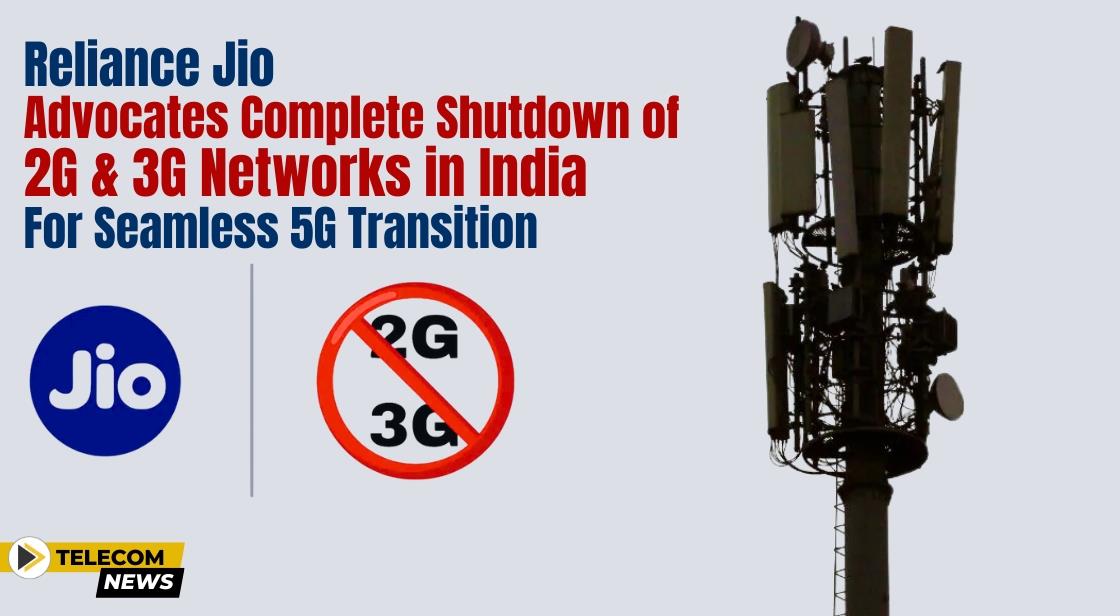Reliance Jio Advocates Complete Shutdown of 2G and 3G Networks in India for Seamless 5G Transition

News Synopsis
Reliance Jio, under the leadership of Mukesh Ambani, is urging the Indian government to implement the complete shutdown of 2G and 3G networks across the country.
The telecom giant's proposal aims to streamline operations, minimize unnecessary costs, and facilitate the smooth transition of all users to 4G and 5G networks. This strategic move by Jio aligns with the evolving digital landscape and the imperative for enhanced connectivity.
Reliance Jio's Perspective:
In response to the Telecom Regulatory Authority of India's (TRAI) consultation paper on 'Digital Transformation through 5G Ecosystem,' Jio emphasized the need for a clear government policy and roadmap for the phased closure of 2G and 3G networks. The company stated, "This will also give great impetus to developing an ecosystem for 5G use cases."
Jio underscored the pivotal role of 5G in driving digital transformation across industries, citing faster data speeds, increased bandwidth, and lower latency as key enablers. The telecom operator envisions 5G as a catalyst for innovation and business growth, offering connectivity capabilities that can significantly contribute to various sectors.
Vodafone Idea's Perspective:
In the same consultation paper, Vodafone Idea (VI) acknowledged the challenges associated with the widespread adoption of 5G, particularly in low-income groups. VI highlighted the prevalence of 2G/3G-enabled smartphones in the country and the cost barriers hindering the transition to 5G-enabled devices.
VI emphasized that a significant portion of the population relies on older technologies like 2G, restricting their access to digital services. The telecom operator suggested that the government consider providing subsidies to encourage users to shift from feature phones to 5G-enabled smartphones. This proposed initiative aims to bridge the digital divide, ensuring broader access to the latest digital technologies and services.
Government's Role and Subsidy Proposal:
Reliance Jio's proposal aligns with the evolving landscape, emphasizing the government's role in facilitating the country's digital transformation. Jio's call for the complete shutdown of outdated networks is seen as a strategic step towards optimizing resources and encouraging innovation in the 5G space.
VI's subsidy proposal reflects a proactive approach to address economic barriers, making 5G-enabled smartphones more accessible to a wider audience. This initiative is envisioned as a means to ensure inclusivity and keep citizens updated on the latest digital advancements.
Striking a Balance Between Progress and Inclusion:
The debate reflects a fundamental question: how can India embrace the promise of 5G while ensuring everyone benefits from the digital revolution? The government faces a delicate task of balancing technological advancement with social responsibility. Finding the right solutions will require:
-
Careful Planning: A well-defined roadmap for network transition, considering infrastructure upgrades, spectrum allocation, and affordability challenges.
-
Collaborative Efforts: Industry players, regulators, and social welfare organizations must work together to bridge the digital divide and ensure inclusive connectivity.
-
Focus on User Education: Empowering users with knowledge and skills to navigate the digital landscape and harness the potential of 5G.
As India navigates this critical juncture, striking a balance between rapid technological growth and inclusive access will be key to unlocking the full potential of the digital age for all its citizens.
Conclusion:
The telecom industry's push for the discontinuation of 2G and 3G services underscores the sector's commitment to advancing digital connectivity in India. As the government evaluates these proposals, the decisions made will significantly impact the nation's digital future, influencing accessibility, innovation, and overall technological progress.
You May Like









